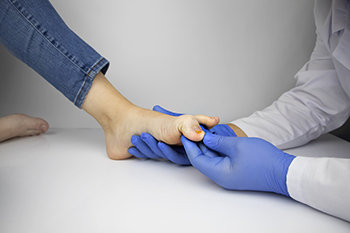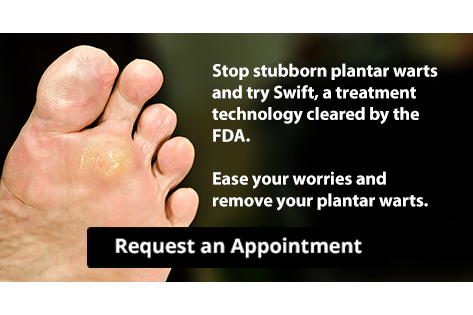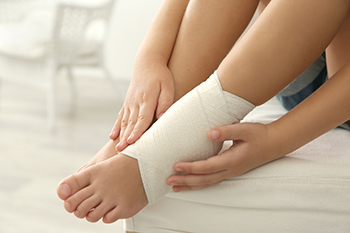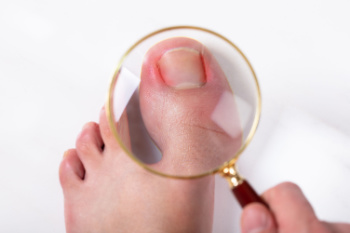Connect With Us
Blog
Items filtered by date: December 2024
Managing a Damaged Toenail

A damaged toenail can result from trauma, fungal infections, or complications like ingrown nails. It is never a good idea to remove a damaged toenail at home, as this can increase the risk of infection or further injury. Symptoms of infection include redness, swelling, pain, and discharge. Without sterile tools and proper techniques, even minor damage to the surrounding skin can invite bacteria and delay healing. A podiatrist can safely assess the extent of the damage and determine the most effective treatment. In some cases, a partial or complete toenail removal may be necessary. This procedure is performed under local anesthesia in a sterile environment and usually takes only 15 to 20 minutes. Following toenail removal, tenderness, redness, and swelling are common. Keeping the foot elevated above heart level for the first 48 hours can help reduce pain and swelling. Toenails grow slowly, often taking six to 18 months to fully regrow. If you have damaged a toenail, it is suggested that you schedule an appointment with a podiatrist for an exam and treatment options.
Toe pain can disrupt your daily activities. If you have any concerns, contact Emil Babayev, DPM of New York. Our doctor can provide the care you need to keep you pain-free and on your feet.
What Causes Toe Pain?
Most severe toe pain is caused due to a sports injury, trauma from dropping something heavy on the toe, or bumping into something rigid. Other problems can develop over time for various reasons.
Toe pain can be caused by one or more ailments. The most common include:
- Trauma
- Sports injury
- Wearing shoes that are too tight
- Arthritis
- Gout
- Corns and calluses
- Hammertoe
- Bunions
- Blisters
- Ingrown toenails
- Sprains
- Fractures (broken bones)
- Dislocations
When to See a Podiatrist
- Severe pain
- Persistent pain that lasts more than a week
- Signs of infection
- Continued swelling
- Pain that prevents walking
Diagnosis
In many cases the cause of toe pain is obvious, but in others, a podiatrist may want to use more advanced methods to determine the problem. These can range from simple visual inspections and sensation tests to X-rays and MRI scans. Prior medical history, family medical history, and any recent physical traumatic events will all be taken into consideration for a proper diagnosis.
Treatment
Treatments for toe pain and injuries vary and may include shoe inserts, padding, taping, medicines, injections, and in some cases, surgery. If you believe that you have broken a toe, please see a podiatrist as soon as possible.
If you have any questions please feel free to contact our offices located in Midwood and Kensington in Brooklyn, NY . We offer the newest diagnostic tools and technology to treat your foot and ankle needs.
Post Pickleball Care

Pickleball’s fast-paced nature and quick movements place significant physical demands on your body, making post-game recovery essential. After playing, a proper cool-down routine helps prevent stiffness and soreness. Light stretches targeting your calves, hamstrings, and ankles can improve flexibility and reduce muscle tension. A short, easy walk also aids circulation, helping your body recover more efficiently. Staying hydrated is critical, as sweating during gameplay can lead to fluid loss that affects muscle function and recovery. Allow your body time to rest, giving overworked muscles a chance to repair and rebuild. Persistent foot or ankle pain should never be ignored. If you are experiencing this, it is suggested that you consult a podiatrist and address any foot or ankle injuries promptly.
If you have any concerns about your feet, contact Emil Babayev, DPM from New York. Our doctor can provide the care you need to keep you pain-free and on your feet.
Biomechanics in Podiatry
Podiatric biomechanics is a particular sector of specialty podiatry with licensed practitioners who are trained to diagnose and treat conditions affecting the foot, ankle and lower leg. Biomechanics deals with the forces that act against the body, causing an interference with the biological structures. It focuses on the movement of the ankle, the foot and the forces that interact with them.
A History of Biomechanics
- Biomechanics dates back to the BC era in Egypt where evidence of professional foot care has been recorded.
- In 1974, biomechanics gained a higher profile from the studies of Merton Root, who claimed that by changing or controlling the forces between the ankle and the foot, corrections or conditions could be implemented to gain strength and coordination in the area.
Modern technological improvements are based on past theories and therapeutic processes that provide a better understanding of podiatric concepts for biomechanics. Computers can provide accurate information about the forces and patterns of the feet and lower legs.
Understanding biomechanics of the feet can help improve and eliminate pain, stopping further stress to the foot.
If you have any questions please feel free to contact our offices located in Midwood and Kensington in Brooklyn, NY . We offer the newest diagnostic and treatment technologies for all your foot and ankle needs.
Foot and Ankle Pains Associated With Pickleball

Pickleball is soaring in popularity as a low-impact, fast-paced sport enjoyed by players of all ages. However, its quick pivots and sudden stops can still lead to foot and ankle injuries. Acute injuries, such as ankle sprains, often occur when the foot rolls inward, called inversion, causing pain and swelling. Falls during gameplay can also lead to fractures or bruising, especially for beginners or those returning to exercise. Overuse injuries like Achilles tendon strain are common, especially in players who increase intensity too quickly without proper warm-ups. These injuries can result in stiffness, swelling, or even tears if untreated. Wearing supportive shoes, strengthening muscles, and maintaining flexibility are key to preventing injuries. If you have injured your foot or ankle while playing pickleball and pain or swelling persists, it is suggested that you visit a podiatrist for an expert diagnosis and tailored treatment, ensuring you get back on the court as soon as possible without compromising your mobility.
Ankle and foot injuries are common among athletes and in many sports. They can be caused by several problems and may be potentially serious. If you are feeling pain or think you were injured in a sporting event or when exercising, consult with Emil Babayev, DPM from New York. Our doctor will assess your condition and provide you with quality foot and ankle treatment.
Common Injuries
The most common injuries that occur in sporting activities include:
- Achilles Tendonitis
- Achilles Tendon Rupture
- Ankle Sprains
- Broken Foot
- Plantar Fasciitis
- Stress Fractures
- Turf Toe
Symptoms
Symptoms vary depending upon the injury and in some cases, there may be no symptoms at all. However, in most cases, some form of symptom is experienced. Pain, aching, burning, bruising, tenderness, tightness or stiffness, sensation loss, difficulty moving, and swelling are the most common symptoms.
Treatment
Just as symptoms vary depending upon the injury, so do treatment options. A common treatment method is known as the RICE method. This method involves rest, applying ice, compression and elevating the afflicted foot or ankle. If the injury appears to be more serious, surgery might be required, such as arthroscopic or reconstructive surgery. Lastly, rehabilitation or therapy might be needed to gain full functionality in the afflicted area. Any discomfort experienced by an athlete must be evaluated by a licensed, reputable medical professional.
If you have any questions, please feel free to contact our offices located in Midwood and Kensington in Brooklyn, NY . We offer the newest diagnostic and treatment technologies for all your foot care needs.
Stop Stubborn Plantar Warts with Swift

Are you frustrated by plantar warts? Plantar warts are commonly found on the soles of the feet or other areas that bear weight. They form due to exposure to the human papillomavirus (HPV). Effectively treat plantar warts with Swift, an FDA-cleared technology that has proven to be highly effective in the removal of plantar warts.
Managing Ankle Sprains

Ankle sprains occur when the ligaments in the ankle are stretched or torn, usually due to twisting or rolling the foot. Sprains are classified into three grades. Grade 1 is mild, where ligaments are stretched, causing mild pain and swelling. Grade 2 is moderate, with partial tearing of ligaments, and moderate pain, swelling, and bruising. Grade 3 is severe, with complete ligament tears, resulting in significant pain, swelling, bruising, and instability. Common symptoms of an ankle sprain include pain, swelling, bruising, limited range of motion, and difficulty walking. The most common causes are sports injuries, uneven surfaces, or sudden twists of the ankle. Treatment typically involves rest and elevation, along with pain relief and targeted exercises to restore strength and flexibility. In severe cases, a podiatrist may recommend immobilization or surgery. If you have suffered an ankle sprain, it is suggested that you schedule an appointment with a podiatrist for a thorough evaluation and treatment plan to prevent further injury and ensure a speedy recovery.
Although ankle sprains are common, they aren’t always minor injuries. If you need your ankle injury looked at, contact Emil Babayev, DPM from New York. Our doctor can provide the care you need to keep you pain-free and on your feet.
How Does an Ankle Sprain Occur?
Ankle sprains are the result of a tear in the ligaments within the ankle. These injuries may happen when you make a rapid shifting movement while your foot is planted. A less common way to sprain your ankle is when your ankle rolls inward while your foot turns outward.
What Are the Symptoms?
- Pain at the sight of the tear
- Bruising/Swelling
- Ankle area is tender to touch
- In severe cases, may hear/feel something tear
- Skin discoloration
Preventing a Sprain
- Wearing appropriate shoes for the occasion
- Stretching before exercises and sports
- Knowing your limits
Treatment of a Sprain
In many cases, the RICE method (Rest, Ice, Compression, and Elevate) is used to treat ankle sprains. However, you should see a podiatrist to see which treatment option would work best with your injury. In severe cases, surgery may be required.
It is important to ask your doctor about rehab options after you receive treatment for your injury. Stretching, strength training, and balance exercises may help the ankle heal while also preventing further injury.
If you have any questions, please feel free to contact our offices located in Midwood and Kensington in Brooklyn, NY . We offer the newest diagnostic and treatment technologies for all your foot care needs.
Ingrown Toenails

Ingrown toenails occur when the edges of the nail grow into the surrounding skin, causing pain, redness, and swelling. This can happen on any toe but is most common on the big toe. Ingrown toenails can develop at the side or tip of the nail, with inner side ingrown toenails being more common. The primary causes include improper nail trimming, such as cutting nails too short or rounding the corners, wearing tight shoes, injury to the toe, or having naturally curved nails. Infections may also develop if left untreated, leading to pus, increased pain, and swelling. Treatment typically involves soaking the foot, applying antibiotics, and, in severe cases, surgically removing part of the nail. A podiatrist can provide expert care by gently removing the ingrown portion of the nail, offering pain relief, and advising on proper nail care to prevent recurrence. If you have an ingrown toenail, it is suggested that you schedule an appointment with a podiatrist for effective treatment and relief.
Ingrown toenails may initially present themselves as a minor discomfort, but they may progress into an infection in the skin without proper treatment. For more information about ingrown toenails, contact Emil Babayev, DPM of New York. Our doctor can provide the care you need to keep you pain-free and on your feet.
Ingrown Toenails
Ingrown toenails are caused when the corner or side of a toenail grows into the soft flesh surrounding it. They often result in redness, swelling, pain, and in some cases, infection. This condition typically affects the big toe and may recur if it is not treated properly.
Causes
- Improper toenail trimming
- Genetics
- Improper shoe fitting
- Injury from pedicures or nail picking
- Abnormal gait
- Poor hygiene
You are more likely to develop an ingrown toenail if you are obese, have diabetes, arthritis, or have any fungal infection in your nails. Additionally, people who have foot or toe deformities are at a higher risk of developing an ingrown toenail.
Symptoms
Some symptoms of ingrown toenails are redness, swelling, and pain. In rare cases, there may be a yellowish drainage coming from the nail.
Treatment
Ignoring an ingrown toenail can have serious complications. Infections of the nail border can progress to a deeper soft-tissue infection, which can then turn into a bone infection. You should always speak with your podiatrist if you suspect you have an ingrown toenail, especially if you have diabetes or poor circulation.
If you have any questions, please feel free to contact our offices located in Midwood and Kensington in Brooklyn, NY . We offer the newest diagnostic and treatment technologies for all your foot care needs.
